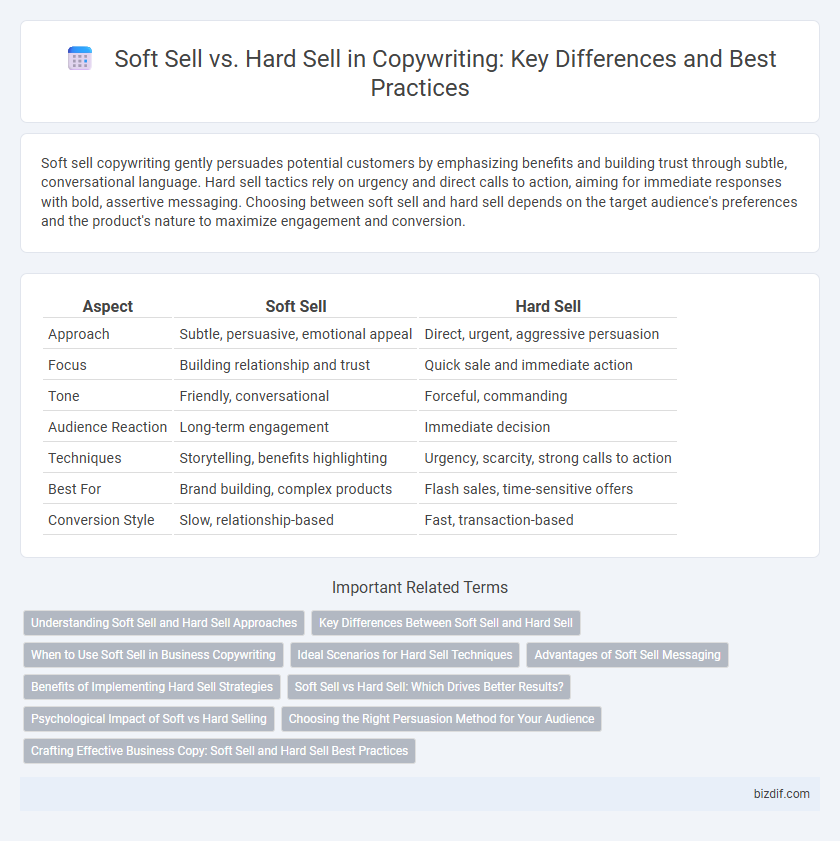Soft sell copywriting gently persuades potential customers by emphasizing benefits and building trust through subtle, conversational language. Hard sell tactics rely on urgency and direct calls to action, aiming for immediate responses with bold, assertive messaging. Choosing between soft sell and hard sell depends on the target audience's preferences and the product's nature to maximize engagement and conversion.
Table of Comparison
| Aspect | Soft Sell | Hard Sell |
|---|---|---|
| Approach | Subtle, persuasive, emotional appeal | Direct, urgent, aggressive persuasion |
| Focus | Building relationship and trust | Quick sale and immediate action |
| Tone | Friendly, conversational | Forceful, commanding |
| Audience Reaction | Long-term engagement | Immediate decision |
| Techniques | Storytelling, benefits highlighting | Urgency, scarcity, strong calls to action |
| Best For | Brand building, complex products | Flash sales, time-sensitive offers |
| Conversion Style | Slow, relationship-based | Fast, transaction-based |
Understanding Soft Sell and Hard Sell Approaches
Soft sell copywriting emphasizes building customer trust and creating an emotional connection through subtle, persuasive language that encourages long-term engagement. Hard sell techniques rely on direct, urgent calls to action and strong, persuasive messaging designed to prompt immediate purchases or responses. Understanding the balance between these approaches helps marketers tailor their strategies to target audiences effectively and optimize conversion rates.
Key Differences Between Soft Sell and Hard Sell
Soft sell copywriting emphasizes subtle persuasion through emotional appeal and storytelling, aiming to build long-term customer relationships by fostering trust and brand loyalty. Hard sell copywriting uses direct, urgent language with clear calls to action and limited time offers to drive immediate purchases and quick conversions. Key differences include tone, with soft sell being gentle and conversational, while hard sell is aggressive and straightforward, targeting different stages of the buying cycle.
When to Use Soft Sell in Business Copywriting
Soft sell techniques excel in nurturing long-term customer relationships by emphasizing trust, value, and subtle persuasion in business copywriting. This approach suits products or services with higher involvement or complex benefits, where customers need time to consider before purchasing. Employing soft sell is ideal for fostering brand loyalty and engaging an audience seeking informative content without pressure.
Ideal Scenarios for Hard Sell Techniques
Hard sell techniques excel in scenarios demanding immediate consumer action, such as flash sales, limited-time offers, or clearance events where urgency drives conversions. These methods are ideal for products with straightforward benefits that require minimal contemplation, like basic household items or last-minute service bookings. Employing a direct, assertive approach effectively cuts through competition in saturated markets, compelling quick decision-making and boosting short-term revenue.
Advantages of Soft Sell Messaging
Soft sell messaging fosters long-term customer relationships by emphasizing trust and emotional connection, leading to higher brand loyalty and repeat business. This approach respects the audience's decision-making process, reducing resistance and increasing the likelihood of conversion through subtle persuasion. Brands utilizing soft sell strategies benefit from enhanced reputation and positive word-of-mouth, driving sustainable growth over time.
Benefits of Implementing Hard Sell Strategies
Hard sell strategies drive immediate consumer action by creating a sense of urgency through clear, direct calls-to-action that boost conversion rates. This approach effectively targets time-sensitive promotions and limited-time offers, maximizing short-term sales performance. Implementing hard sell tactics can significantly enhance revenue by capturing decisive buyers who respond well to straightforward, persuasive messaging.
Soft Sell vs Hard Sell: Which Drives Better Results?
Soft sell copywriting emphasizes subtle persuasion through storytelling and emotional connection, which fosters trust and long-term customer loyalty. Hard sell tactics rely on direct, urgent calls to action and high-pressure language that can drive immediate sales but may risk alienating potential buyers. Data shows soft sell strategies often deliver better results in brand retention and customer lifetime value, while hard sell methods excel in short-term conversion spikes.
Psychological Impact of Soft vs Hard Selling
Soft selling leverages subtle persuasion techniques that build trust and foster long-term customer relationships by appealing to emotions and intrinsic motivations. Hard selling employs direct, assertive tactics designed to create urgency and prompt immediate purchases, often triggering psychological pressure and resistance. Understanding these psychological impacts helps marketers tailor strategies to enhance engagement and conversion based on consumer behavior and preferences.
Choosing the Right Persuasion Method for Your Audience
Soft sell copywriting emphasizes subtle persuasion through storytelling, emotional appeal, and building trust, making it ideal for audiences seeking long-term relationships and value. Hard sell techniques use direct, urgent calls to action and strong incentives, effectively targeting consumers who respond to immediate benefits and quick decisions. Selecting the right method depends on audience psychology, product type, and buying stage to maximize engagement and conversion rates.
Crafting Effective Business Copy: Soft Sell and Hard Sell Best Practices
Crafting effective business copy requires understanding the distinct advantages of soft sell and hard sell techniques; soft sell leverages subtle persuasion and emotional connection to build long-term customer relationships, while hard sell emphasizes urgency and direct calls to action to drive immediate sales. Employing storytelling, empathy, and value-driven content enhances soft sell effectiveness, whereas clear benefits, strong guarantees, and limited-time offers optimize hard sell campaigns. Balancing tone, audience insights, and clear messaging ensures persuasive copy that aligns with brand goals and customer expectations.
Soft Sell vs Hard Sell Infographic

 bizdif.com
bizdif.com